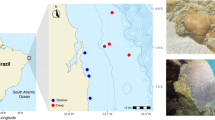Abstract
The effect of Black Band Disease (BBD) among colonies ofMontastrea annularis, M. cavernosa, Diploria strigosa, D. labryinthiformis, S. siderea andColpophyllia natans was determined at 7 shallow locations in the Virgin Islands. Between September 1988 and November 1988, 0.2% of 9204 colonies of these species were infected with BBD in 6908 m2 of reef at 22 randomly chosen areas. Infected colonies were not clumped suggesting that the disease is not highly infectious between colonies. BBD infection rates in areas surveyed 4 times between August 1988 and September 1989 in Greater Lameshur Bay, St. John, USVI, were significantly lower in winter compared to summer. BBDs were found on 5.5% of the colonies ofD. strigosa in Fall 1988, and 7 out of 12 infected colonies lost >75% of their tissue in 6 months. Low level, chronic BBD infections could convert 3.9% of the living cover ofD.strigosa to free space per year, thereby creating substrata for successional processes.
Similar content being viewed by others
References
Antonius A (1973) New observations on coral destruction in reefs. 10th Meeting Assoc Isl Mar Lab Carib 10:3 (abstr)
Antonius A (1977) Coral mortality in reefs: a problem for science and management. Proc 3rd Int Coral Reef Symp 2:3–6
Antonius A (1981) The “Band” diseases in coral reefs. Proc 4th Int Coral Reef Symp 2:7–14
Antonius A (1985a) Coral diseases in the Indo-Pacific: a first record. PSZNI Mar Ecol 6:197–218
Antonius A (1985b) Black band disease infection experiments on hexacorals and octocorals. Proc 5th Int Coral Reef Symp 6:155–160
Antonius A (1988) Distribution and dynamics of coral diseases in the eastern Red Sea. Proc 6th Int Coral Reef Symp 2:293–298
Connell JH (1978) Diversity in tropical rain forests and coral reefs. Science 199:1302–1310
Connell JH, Keough MJ (1985) Disturbance and patch dynamics of subtidal marine animals on hard substrata. In: Pickett STA, White PS (eds) The ecology of natural disturbance and patch dynamics. Academic Press, New York, pp 125–151
Edmunds PJ, Roberts DA, Singer R (1990) Reefs of the northeastern Caribbean I. Scleractinian populations. Bull Mar Sci 46:780–789
Feingold JS (1988) Ecological studies of a cyanobacterial infection on the Caribbean sea plumePseudopterogorgia acerosa (Coelenterata: Octocorallia). Proc 6th Int Coral Reef Symp 3:157–162
Garrett P, Ducklow H (1975) Coral diseases in Bermuda. Nature 253:349–350
Gladfelter WB, Gladfelter EH, Monahan RK, Ogden JC, Dill RF (1977) Environmental studies of Buck Island Reef National Monument, St Croix US Virgin Islands. Spec Rept Nat Park Serv US Dept Int, p 137
Goreau TF (1959) The ecology of Jamaican coral reefs I. Species composition and zonation. Ecology 40:67–90
Jackson JBC (1977) Competition on marine hard substrata: the adaptive significance of solitary and colonial strategies. Am Nat 111:743–767
Loya Y (1976) Effects of water turbidity and sedimentation on the community structure of Puerto Rican corals. Bull Mar Sci 26:450–466
Mitchell R, Chet I (1975) Bacterial attack of corals in polluted seawater. Microb Ecol 2:227–233
Peters EC (1984) A survey of cellular reactions to environmental stress and disease in Caribbean scleractinian corals. Helgol Wiss Meeresunters 37:113–137
Peters EC (1988) Symbiosis to pathology: are the roles of microorganisms as pathogens of coral reef organisms predictable from existing knowledge? Proc 5th Int Coral Reef Symp 1:205–209
Ramos-Flores T (1983) Lower marine fungus associated with black line disease in star corals (Montastrea annularis, E & S). Biol Bull 165:429–435
Rogers CS, Teytaud R (1988) Marine and terrestrial ecosystems of the Virgin Islands National Park and Biosphere Reserve. Biosphere Reserve Report 29, US Department of the Interior National Park Service, p 112
Rützler K, Santavy DL, Antonius A (1983) The Black Band Disease of Atlantic Reef Corals III. Distribution, ecology, and development. PSZNI Mar Ecol 4:329–358
Sokal RR, Rohlf FJ (1981) Biometry. Freeman, New York, p 859
Szmant-Froelich A (1985) The effect of colony size on the reproductive ability of the Caribbean coralMontastrea annularis (Ellis and Solander). Proc 5th Int Coral Reef Symp 4:295–300
Woodley JD and 19 others (1981) Hurricane Allen's impact on Jamaican coral reefs. Science 214:749–755
Zar JH (1984) Biostatistical analysis. Prentice Hall, New Jersey, p 718
Author information
Authors and Affiliations
Rights and permissions
About this article
Cite this article
Edmunds, P.J. Extent and effect of Black Band Disease on a Caribbean reef. Coral Reefs 10, 161–165 (1991). https://doi.org/10.1007/BF00572175
Accepted:
Issue Date:
DOI: https://doi.org/10.1007/BF00572175




